by Nikki Ralston, Exhibitions
One of the pleasures of our collections is that they provide the opportunity to appreciate not only the differences between the past and our own times, but to recognise something of ourselves in those who inhabited that past. Just when you least expect it you’ll come across a phrase or fact that allows you a sense of connection with the writer. You might think this is a really odd observation to make in relation to Topographia Hiberniae and Expugnatio Hibernica (or The Topography of Ireland and The Conquest of Ireland). After all, these famous late 12th century works, by Giraldus Cambrensis or Gerald of Wales or Gerallt Gymro, were central in creating long lasting, negative stereotypes of Ireland. Given that, would you expect or even want, to find common ground? Well, as surprising as it may seem, the parallels are there, waiting to be found.
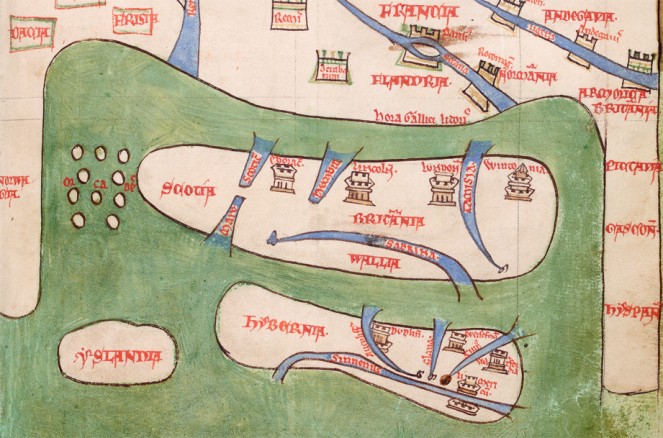
Detail from the map of Europe in the Topographia showing Hibernia (Ireland) with Iceland nestling off the north coast. Dublin, Wexford, Waterford and Limerick are depicted as are the Rivers Liffey, Slaney, Suir and Shannon. NLI ref. Ms. 700
Giraldus’ two journeys to Ireland in the period 1183-86, during the aftermath of the Norman invasion, were the basis for both works. You can enjoy the beauty of Ms. 700 (as we also know it here at Library Towers), through the snazzy image viewer on our catalogue. But you have to look beyond this surface to understand the message and motivation behind that text; that Ireland was a "primitive" nation, whose invasion could be justified by the "civilising mission of the conquerors" (R.R. Davies, Domination & Conquest, 113)
In this story, context is everything. Born c. 1146, in Pembrokeshire, little is known of Giraldus' early life, but he spent 13 years in Northern France, from 1162. There he studied law, philosophy and theology in preparation for his career as a cleric. 12th century France was home to a cultural flourishing, which Giraldus could hardly fail to have experienced and, as we’ll see, he does demonstrate a love of beauty.
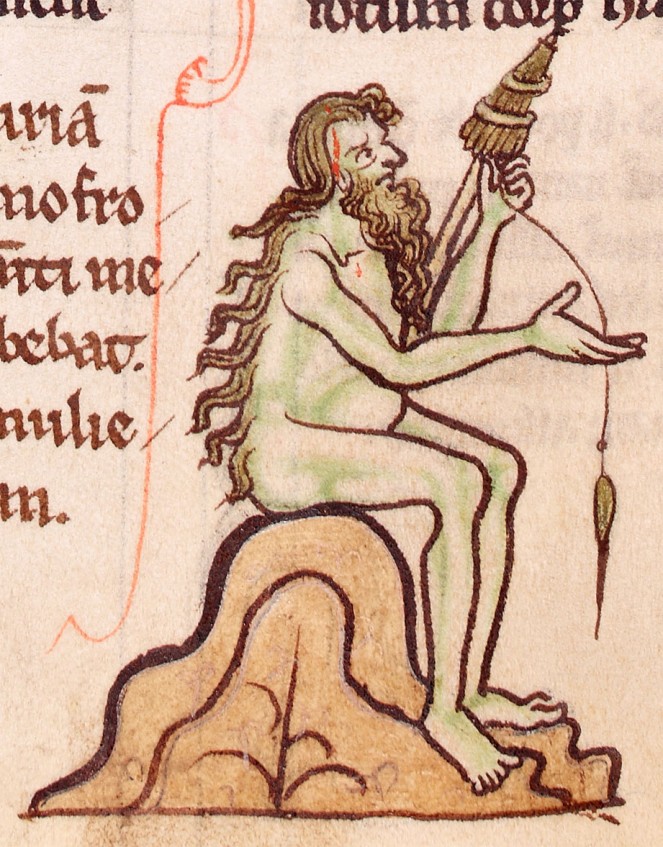
Giraldus described this bearded woman (yes, really!) who was part of the court of Duvenaldus, king of Limerick. J.J. O'Meara translates this section from the manuscript: "... She followed the court wherever it went, provoking laughs as well as wonder. The fact that her spine was hairy is no indication of sex. In wearing her beard long she was following the custom of her fatherland, not of her sex!” NLI ref. Ms. 700
However, Giraldus’ scholarly abilities should not be allowed to obscure the fact that his loyalties lay firmly with the Norman establishment. Not only was he the son of William de Barri, a Welsh/Norman lord, but his maternal grandmother was Nest, a Welsh princess and mistress of King Henry I, whose children founded the Fitzstephen, Fitzgerald and Fitzhenry families. Therefore, Giraldus was closely related to many of the invasion's key figures. These included various cousins; his brothers Robert and Phillip; his paternal half brothers, the de Cogans; and his mother's brother, Maurice Fitzgerald, founder of the powerful Geraldine dynasty, whose descendants later held the Earldoms of Offaly, Kildare, and Desmond, and Duchy of Leinster.
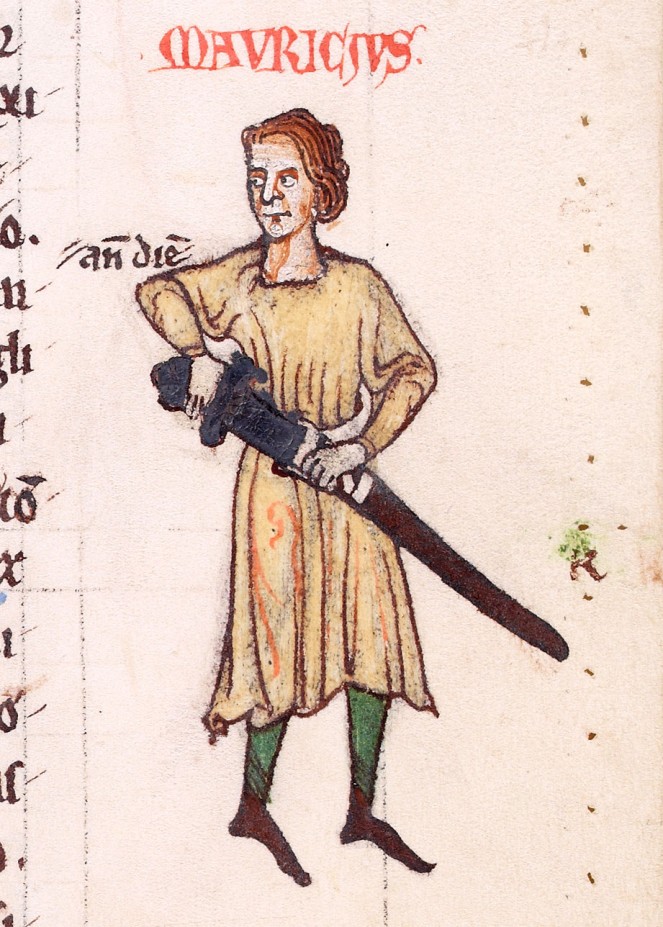
This is Giraldus' Uncle Maurice - Maurice Fitzgerald, founder of the powerful Geraldine dynasty. NLI ref. Ms. 700
"History is written by the victors" is Churchill's oft-quoted reminder that recorded history can present a distorted picture. But, when history is written by the brother/nephew/cousin of the victors, and is also tutor to Lord John (heir to the English throne), we should hardly expect a balanced account of events. And here is an unflattering example of where we might recognise ourselves in Giraldus, for he is human and fallible in "his notorious bias in favour of his own relations" (A.B. Scott & F.X. Martin, The Conquest of Ireland, xxi) which whilst not recommended, can perhaps, be understood:
“It would be unnatural for Giraldus not to favour his own family and connection, and Giraldus is only too human. It would be equally strange if his views on Ireland and the Irish were not influenced by his educational and social background as a member of the educated elite produced by the schools of northern France, and by his belonging to a family which had long been in Wales, but in which the Norman strain was still dominant". (Davies, xxv)
Family bias is central in his attempts to justify the invasion. By portraying the Irish as primitive and in need of civilisation, Giraldus followed the established Norman "party line". Sadly, we can recognise this path as having been well-worn by many other invading powers in conflicts around the world, before and since. For me, R.R. Davies' comments in Domination and Conquest: The experience of Ireland, Scotland and Wales 1100-1300, have a resonance, applicable to so many contexts; historic, modern and current:
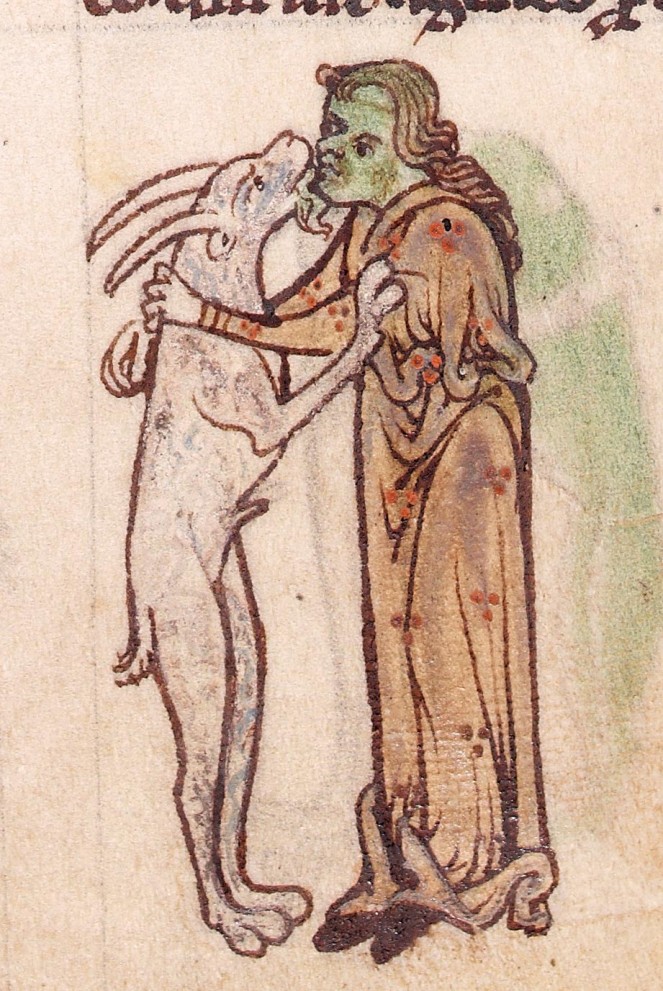
Just one of the illustrations in the Topographia that depicts the Irish as being a little too fond of their animals. NLI ref. Ms. 700
"The creation of these stereotyped images ... are of great interest in the study of the mentality of domination. As so often with such images they tell us as much, if not more, about the world of the image-makers as about the societies they are attempting to characterize. The images, created as they were by an ecclesiastical and intellectual elite, speak to us of a Europe where a set of international norms was being established”. (Davies, 22)
At many points in the text of Topographia Hiberniae, Giraldus thoroughly enjoys himself while outlining the less than civilised behaviour of the Irish - here on a new and outlandish way of conferring dominion and kingship:
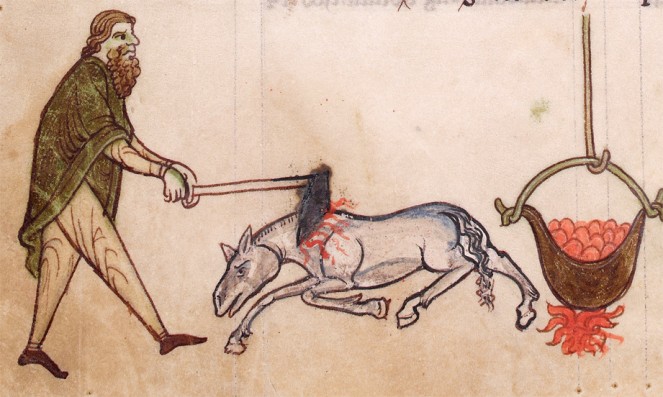
"... the mare is then killed immediately, cut up in pieces, and boiled in water..." NLI ref. Ms. 700
"There are some things which, if the exigencies of my account did not demand it, shame would discountenance their being described. But the austere discipline of history spares neither truth nor modesty. There is in the northern and farther part of Ulster, namely Kenelcunill [Tyrconnell], a certain people which is accustomed to consecrate its king with a rite altogether outlandish and abominable. When the whole people of that land has been gathered together in one place, a white mare is brought forward into the middle of the assembly. He who is to be inaugurated, not as chief, but as a beast, not as a king, but as an outlaw, embraces the animal before all, professing himself to be a beast also. The mare is then killed immediately, cut up in pieces, and boiled in water. A bath is prepared for the man afterwards in the same water. He sits in the bath surrounded by all his people, and all, he and they, eat of the meat of the mare which is brought to them. He quaffs and drinks of the broth in which he is bathed, not in any cup, or using his hand, but just dipping his mouth into it round about him. When this unrighteous rite has been carried out, his kingship and dominion has been conferred..." (John J. O'Meara, Giraldus Cambrensis, 93-4)
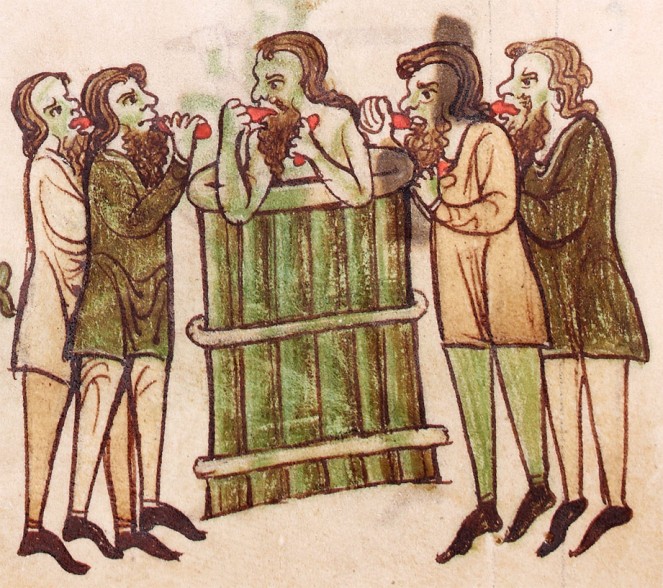
"... He sits in the bath surrounded by all his people, and all, he and they, eat of the meat of the mare which is brought to them..." NLI ref. Ms. 700
So far, so negative? I thought so too, until I remembered the quirky beauty of this book. And this was where I found a more attractive example of how we might identify with Giraldus. You love books, don’t you? Not just the information they contain, but the physical object itself? Me too. And as it turns out, in this respect, Giraldus is one of us! For despite the family ties and elitist prejudices, it would appear that he could not help but be bowled over by Irish book illumination. My favourite image from the Topographia is that of the scribe at work, as used in the Your NLI project. It illustrates the story of a miraculous book produced in Kildare, through angelic inspiration and the intercession of St. Brigid. The enthusiastic and vivid manner in which Giraldus describes this book indicate first hand experience. Though written over 800 years ago, his reaction is timeless and I suspect would strike a chord with any bibliophile. I hope that you'll enjoy, and perhaps recognise, the delight Giraldus expresses in the passage below:
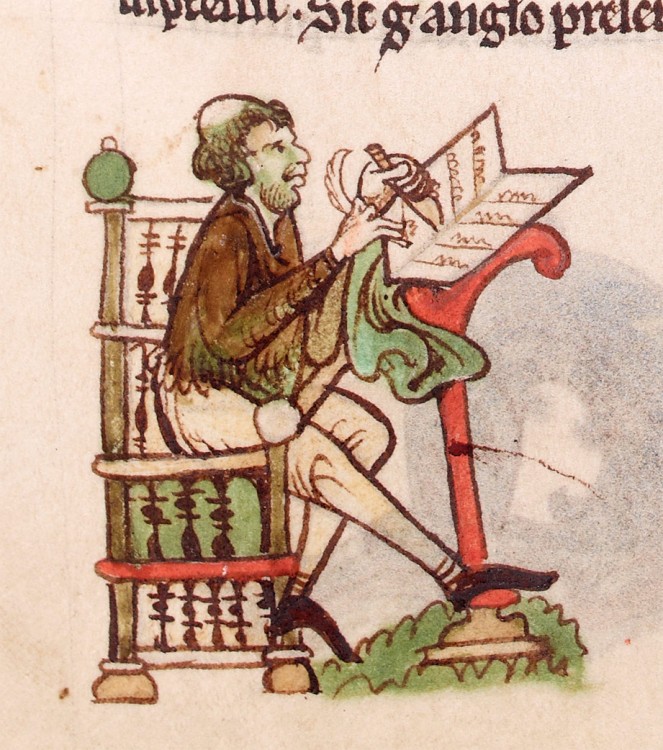
A scribe occupied in artistry that Giraldus Cambrensis thought must have been the work "not of men, but of angels". NLI ref. Ms. 700
"Here you can look on the face of the divine majesty drawn in a miraculous way; ... If you look at them carelessly and casually and not too closely, you may judge them to be mere daubs rather than careful compositions. You will see nothing subtle where everything is subtle. But if you take the trouble to look very closely, and penetrate with your eyes the secrets of the artistry, you will notice such intricacies, so delicate and subtle, so close together and well-knitted, so involved and bound together, and so fresh still in their colourings that you will not hesitate to declare that all these things must have been the result of the work, not of men, but of angels." (O'Meara, 84)
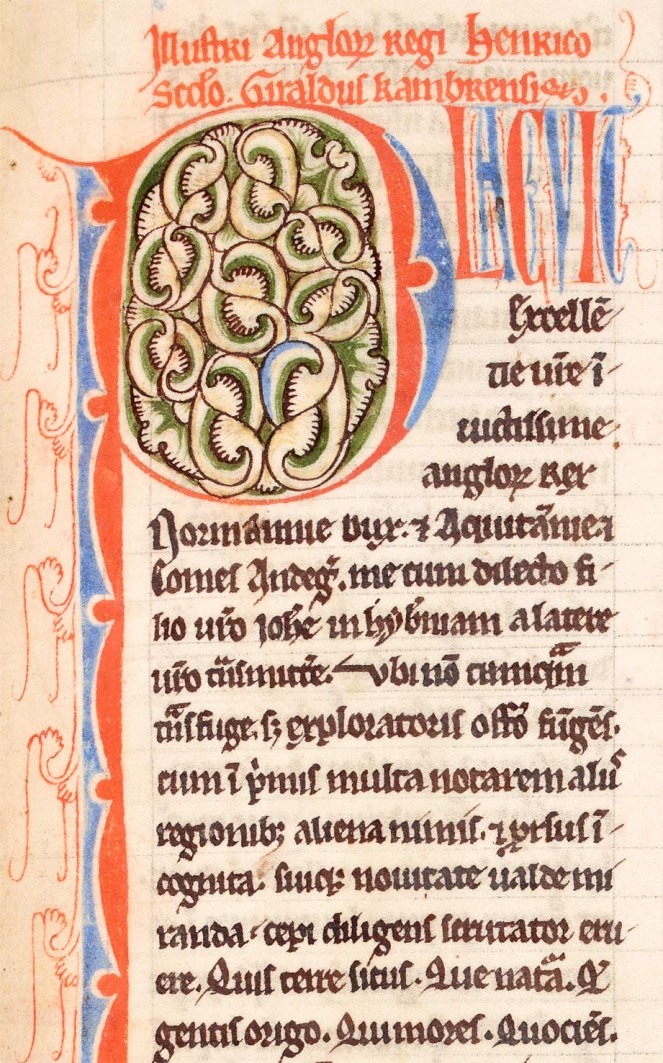
A beautifully illuminated capital P. NLI ref. Ms. 700
If this has left you wanting to know more about the Norman invasion of Ireland or the history of illuminated manuscripts you may find the following bibliography with direct links to our catalogue helpful:
Giraldus Cambrensis & Norman Invasion
Domination and Conquest by R.R. Davies, 1990. NLI ref. Ir 94103 d 4
Ireland and Britain, 1170-1450 by Robin Frame,1998. NLI ref. Ir 94103 f 2
Gerald and his World by Robert M. Morris, 1987. NLI ref. 1B 125
The History and Topography of Ireland translated from the Latin by John J. O’Meara, 1982. NLI ref. Ir 94101 g 4
Expugnatio Hibernica: The Conquest of Ireland by Giraldus Cambrensis by A.B. Scott & F.X. Martin (eds.), 1978. NLI ref. Ir 94101 g 3
When the Normans came to Ireland by Maurice Sheehy, 1975. NLI ref. Ir 94102 s 3
From Kings to Warlords by Katherine Simms, 1987. NLI ref. Ir 941 s 27
The History of Illuminated Manuscripts
The Illuminated Page by Janet Backhouse, 1997. NLI ref. 1B 3122
Understanding Illuminated Manuscripts by Michelle Brown, 1994. NLI ref. 2A 1465
Scribes and Illuminators by Christopher De Hamel, 1992. NLI ref. Ir 745 d 14
The Book of Kells by Bernard Meehan, 2009. NLI ref. 10B 350
Exploring the Book of Kells by George Otto Simms, 2007. NLI ref. 10A 58
The Gilded Page by Kathleen P. Whitley, 2000. NLI ref. 6A 96
Bean an Phoist suggests: When you're finished getting up close and really personal with our Topographia Hiberniae, have a look at the just launched Book of Kells for iPad app...

